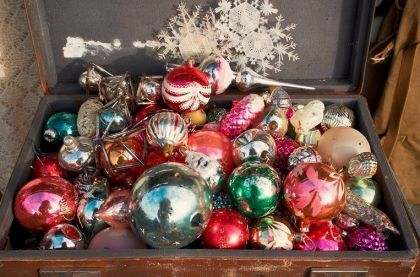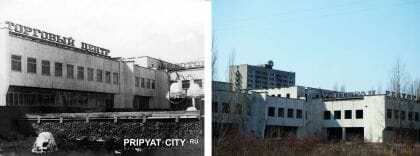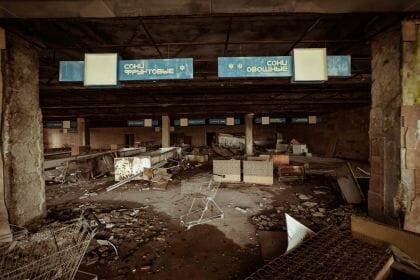This is a special season in much of the world. While Catholics have always celebrated Christmas, probably as the main holiday of the year, the Soviet Union didn’t recognize religious holidays, so it made up its own – civil ones – New Year. How did people celebrate the New Year in Soviet cities like Pripyat?
Officially, Pripyat was born during Soviet times as one of the Ukrainian cities on 4th February 1970. During this time, Winter feast’s traditions were formed in Soviet everyday culture, some of which are still relevant.
For many in the Soviet Union, New Year’s Eve remained a family holiday, just like Christmas, so gathering around the feast table with all their relatives was a must on this day. Let’s see how residents of the city of Pripyat celebrated the beginning of the new year.
No Christmas
In countries where people profess Catholicism, they have always celebrated Christmas, probably as the main holiday of the year, the Soviet Union didn’t recognize religious holidays. “The irrevocable and complete elimination of the Christmas celebration” took place in 1929, turning Christmas day into a working day.
Authorities banned all religious celebrations and for over 70 years people didn’t celebrate the birth of Jesus Christ at all.
 Soviet poster against Christmas, 1930. The poster shows drunk priests trying to stop a man from going to work. Translation: “Organized labor day instead of Christmas”.
Soviet poster against Christmas, 1930. The poster shows drunk priests trying to stop a man from going to work. Translation: “Organized labor day instead of Christmas”.
However, people were used to the annual winter feasts – they needed joy and a break from the hard work and dark cold days – so the Communist Party decided to arrange a fir tree party for peasants and proletarians on New Year’s Eve.
The New Year has become a familiar and traditional family holiday for Soviet people, as well as for Pripyat residents – it has been celebrated in a rather monotonous manner: with an elegant Yolka (Christmas tree), a festive table and the speech by the head of the family.
They very carefully prepared for the celebrations in advance and the New Year was celebrated by all strata of society and representatives of all nationalities.
Yolka — the New Year’s tree.
Since the “Christmas ban” was established, the Soviet people named the main winter’s tree as “Yolka” or just simply New Year’s tree.
 Tree fair, 1980,
Tree fair, 1980,
Photo: RIA Novosti, Lev Ustinov
In the Soviet Union, there was not a big variety – New Year’s trees were bought at a tree fair. Every December in Pripyat was the same market, where residents could buy not only real trees, but also plastic ones. Then was the most joyful part – the decoration.

Tree decorations which were in almost every Soviet house. They were in short supply, that’s why they were treated very carefully, kept for a long time, decorating the New Year’s tree from year to year.
New Year’s decorations reflected the history and main attributes of the Soviet Union: depicting USSR symbols, a red five-pointed star on the top of the tree, cosmonauts, animals, vegetables etc.

Soviet tree decorations – from left to right: decoration with the USSR title, Soviet cosmonaut, corn (depicting the Nikita Khrushchev’s corn campaign).
The main heroes of New Year’s decor in the USSR were traditionally garlands and tinsel, and windows, if possible, were decorated with colored bulbs.
 Family decorates “Yolka” for the New Year, 1980s.
Family decorates “Yolka” for the New Year, 1980s.
A technological novelty of the 1980s was the so-called light music – a garland that was connected to a TV set so that it blinks in time with the sounds of the air. Living in such a well developed city, the inhabitants of Pripyat could easily buy such innovation.
 Electric garland “Kapelka” (“Droplet”), USSR, 1980s.
Electric garland “Kapelka” (“Droplet”), USSR, 1980s.
There was not much music on television, so often the garlands continued to blink in unison with the speeches of the Politburo members.
The Soviet Union had established a tradition – a New Year tree was installed on the main square in every city. Pripyat wasn’t an exception. Of course, the main tree of the city set right on the central square of Pripyat, opposite the Palace of Culture Energetik was considered to be a “green beauty.” During the winter holidays, all festivals, fairs and celebrations were held there.
 Young citizen of Pripyat on the main square in front of the Palace of Culture Energetik.
Young citizen of Pripyat on the main square in front of the Palace of Culture Energetik.
Photo: Kachalov Eduard
Source: Pripyat-City.ru
“And what a tree we had every year! Tall, colorful, adorned with beautiful toys! It was a tradition for every resident of Pripyat to visit our New Year’s tree. When you come to the main square, look at the tree and immediately the New Year mood appears”, remembers former Pripyat resident Alexey Moskalenko.
 Family in Pripyat Amusement Park, 1985.
Family in Pripyat Amusement Park, 1985.
Of course, don’t forget about the Pripyat Amusement Park. The official opening of the park was planned on 1st of May 1986 (which didn’t happen), so therefore all city residents waited with bated breath.
Hunting For Food
It was necessary to prepare for the holidays in the USSR ahead of time. People used to procure the “best” food they could find and try to get goods that were not readily available.
 Caricature on the theme – deficit of goods in the USSR. Translation: “Sorry, dear, I’ll just check what they sell”.
Caricature on the theme – deficit of goods in the USSR. Translation: “Sorry, dear, I’ll just check what they sell”.
Before the New Year, scarce products were “thrown out” (slang word at those times meaning – expose goods for sale) on the counters of Soviet grocery stores. It could take several months to prepare for the New Year’s table, purchasing products in short supply: sausages, fish, red and black caviar, canned food etc. On New Year’s Eve, long queues lined up in each shop, where people сould wait for hours.
Soviet “planned” trade could not provide the population with the necessary amount of even such simple products. That is, the fact that you stood in line did not guarantee you that you would definitely receive the goods in your hands – often it could run out right in front of your nose, and then you left the store empty-handed.
 Typical example in Soveit Union: Queue for cakes for New Years, 1980s.
Typical example in Soveit Union: Queue for cakes for New Years, 1980s.
Almost 50 000 people were Pripyat residents, but they hadn’t such huge problems with queues as other Soviet people:
“We had everything in the stores. After the accident, when we got to other cities, we fully understood how well we lived and how happiness disappeared in an instant …” – from memories of a Pripyat citizen.
There were 25 different shops in the city. One of the most popular stores was the Shopping Center on the main square – modern and luxury with shopping cars.
 “Torhovyi Zentr” simply shopping center or shopping mall was considered as one of the best in the city of Pripyat.
“Torhovyi Zentr” simply shopping center or shopping mall was considered as one of the best in the city of Pripyat.
Old photo: Pripyat-City.ru
In the Pripyat Shopping Center, there was a grocery department on the first floor and a furniture department on the second. In the grocery department were: meat, canned food, cheese, beer, juice departments etc. At that time, the store was considered one of the best in the city.
 Shopping Center nowadays.
Shopping Center nowadays.
Photo: CHERNOBYLX
The point is that since the Chernobyl Nuclear Power Plant was a subject straight to Moscow, and Pripyat was its atomograd, basic social services and needs were directed from Moscow too, therefore it had at the same level as in the capital of the Soviet Union.
Fun Fact: Residents from neighboring villages also wanted to visit this modern miracle, which in turn created even longer queues in Pripyat. This however got the residents so annoyed that they were seriously considering the plan to install one grocery store at the entry to Pripyat, especially for the non-residents.
The Festive Table

Some of the main dishes on the festive table: Olivier salad, red caviar, boiled pork (can be any other salami or ham), tangerines, Russian Vodka and Soviet Champagne.
A distinctive feature of the New Year’s table has always been the abundance of all kinds of snacks and salads. Olivier salad has always been an obligatory attribute. Not a single New Year’s table would do without this dish.
On the table, including the Olivier salad and covered with a fresh festive tablecloth, you would usually find such dishes for the upcoming feast, such as: herring in “shuba-coat”, kholodets (a savoury gelatin dish made with a meat stock or consommé), sandwiches with sprats, canned vegetables and fruits. For dessert – cake, sweets, and tangerines (because they were only available in the Winter).
 New Year celebration, Pripyat, 1984.
New Year celebration, Pripyat, 1984.
It was such a tradition to use crystal, porcelain, and ceramic dishes (festive ones, which we used only for special occasions) for New Year’s table. It was believed that the New Year’s table should be with the best dishes, bursting with food – in this case, the abundance in the house will remain for the whole year.
“I remember how my wife got out our crystal dishes of the buffet table with all the honors and celebrations”, remembers one of the former Pripyat citizens.
Of course, the New Year was considered a family holiday, but this did not stop Pripyat residents from celebrating it in a restaurant, and even more so in such a luxurious one as the Polissya restaurant.
 1985–86 December, 31st. New Year’s Eve at the Polissya restaurant.
1985–86 December, 31st. New Year’s Eve at the Polissya restaurant.
Source: Pripyat-City.ru
In the 70s, a tradition appeared to celebrate the New Year by the TV set, which by that time had already become widespread. From that time the last stage of preparation was to wipe (fix) the TV, which was considered “the best decoration of the New Year’s table.” Leonid Brezhnev became the founder of the tradition of the annual televised address of the Head of State to the people.
In 1964, the first New Year’s TV show, “Goluboy Ogonyok” (The Little Blue Light) was released on television.
The most popular TV show in the USSR during New Year’s celebration. Episode from New Year 1986.
During the Soviet times, Soviet New Year films and fairy tales for children were also very popular: one of the most popular films – The Irony of Fate, fairy tale Morozko, film Carnival Night.
 Frame from a fairy tale “Morozko” (Frost).
Frame from a fairy tale “Morozko” (Frost).
“My daughter just loved watching fairy tales, especially on New Year’s Eve. I remember she was only 5 years old when she saw the fairy tale “Frost” for the first time, she was delighted! And then at the children’s party in the Palace of Culture Energetik when she came to Grandfather Frost (author’s note – Soviet Santa), she named him as Morozko, the main character of the fairy tale. Years after she still believed that he was real. It was so funny!” – says a former resident of Pripyat city.
Soviet Santa – Ded Moroz and New Year Children’s Party
 Ded Moroz (Grandfather Frost) and Snegurochka (Snowgirl) drink tea, 1981
Ded Moroz (Grandfather Frost) and Snegurochka (Snowgirl) drink tea, 1981
Photo: TASS
One of the main symbols of New Year was Grandfather Frost (Ded Moroz), who is considered the Russian analogue of Santa Claus and has been recognized since the 19th century. In the 1930s, the image of his granddaughter, Snegurochka (Snowmaiden) also became popular. Since then, they’ve ‘operated’ together to bring joy and gifts.
Pripyat was a young city, not because of its age, but because of the residents. There lived young people aged 23-28 years old with their families (almost in each family were kids). That’s why there were 5 schools and 15 kindergartens in the city.
At the end of December, each school and kindergarten arranged a New Year children’s party. Kids prepared amateur performances, masquerades – favorite types of celebrations, where they played in handmade costumes.
 Kindergarten “Radostnyi” (Joyful) №14, group № 5, 1986, Pripyat.
Kindergarten “Radostnyi” (Joyful) №14, group № 5, 1986, Pripyat.
Photo: Pripyat resident archive
Grandfather Frost and his helper granddaughter Snegurochka were main guests. Children would wait for gifts from Grandfather Frost—who always wears a red robe and black boots and has a white beard.
For this party they dressed up like bunnies, foxes, snowflakes etc. On this day, children were allowed to dye and curl their hair, and masks made of painted papier-mâché became the highlight of the celebration.
Very often such celebrations were established at work, for example at Pripyat city police station.
 New Years children’s party at the Pripyat department of internal affairs.
New Years children’s party at the Pripyat department of internal affairs.
Photo: Pripyat resident archive
The Soviet New Year were also obligatory gifts for the children of employees from the enterprise where the parents worked. As a rule, in those days everyone worked – both the father and the mother, so each child in the family received two bags of sweets. The truth in these packages was that today’s children would hardly seem festive and special – simple caramels and apples, sometimes tangerines and oranges.
At work, parents were given free tickets to the New Year party for kids at the Palace of Culture, where New Year’s performances were held with Ded Moroz and Snegurochka. Every year, Pripyat workers got tickets to such parties in the Palace of Culture Energetik.
 New Year children’s party in the Palace of Culture Energetik, Pripyat, 1986.
New Year children’s party in the Palace of Culture Energetik, Pripyat, 1986.
Source: Pripyat-City.ru
But in addition to the parties at school or kindergarten, there was another, more important one – a celebration near the main tree. Traditionally, it took place in the Palace of Culture Energetik. Each child of Pripyat dreamed of going there and their parents tried their best to get a ticket. At the end of the performance, each child received a gift with sweets from Ded Moroz.
Source: PRIPYAT-film
New Year children’s party in the Palace of Culture Energetik, Pripyat, 1986.
The Soviet New Year meant inexpensive gifts for adults and children, but obligatory New Year trees, parties, carnivals, masquerades and parties in schools and work collectives. This is a lot of fun, common festivities and traditions, including such as going to the bathhouse with friends on New Year’s Eve.
Thus, the New Year became the most celebrated non-ideological holiday in the country. It became a tradition to celebrate the New Year with family and close friends, find gifts under the tree (where they are allegedly placed by Grandfather Frost), and have a festive dinner. People tried to complete the work they had begun, summed up the results of the outgoing year, to say goodbye to the passing year and hello to the coming year.
Our dear travelers!
It’s been a hard year for everyone – from those who were forced to stay at home to those who were forced to go to work. But it’s time to put all the hardships aside to welcome the new year with happiness, joy and fervour with our loved ones.
We wish you a happy and healthy New Year! And of course looking forward to an extremely interesting adventures in Chernobyl Zone with you!
Radioactively yours ChernobylX.



 ChernobylX
ChernobylX
 ChernobylX
ChernobylX